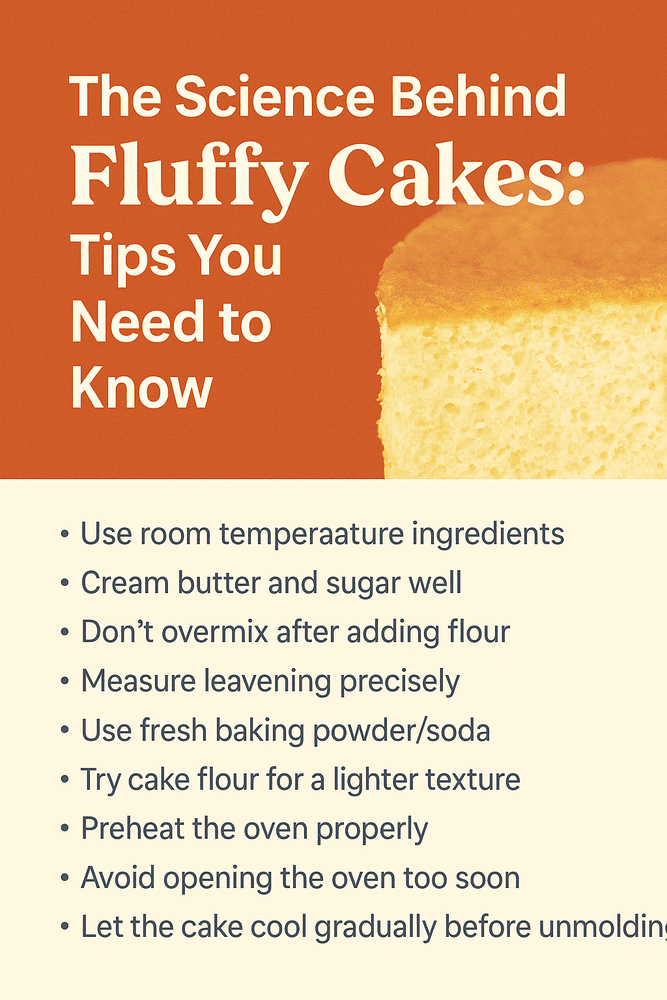There’s nothing quite like slicing into a cake and seeing that soft, airy texture inside. A fluffy cake feels light on the fork, melts in your mouth, and keeps people coming back for more. But what exactly makes a cake fluffy? Is it just the ingredients, or is there science involved? The truth is: both.
In this article, we’ll explore the key scientific principles that help you bake fluffier cakes—from understanding leavening agents to mastering mixing techniques and ingredient temperatures. If your cakes are turning out too dense, too wet, or just flat, these tips will help you transform them into bakery-quality masterpieces.
Understanding fluffiness begins with air. Fluffy cakes contain a lot of tiny air bubbles that expand during baking, giving the cake its rise and tender structure. If the batter doesn’t trap enough air, or if the structure collapses, the result is a dense, heavy cake.
One of the biggest contributors to a fluffy cake is proper creaming. Creaming means beating butter and sugar together until the mixture becomes pale and fluffy. This step incorporates air into the batter. The sugar crystals cut into the butter, creating tiny air pockets. When heated in the oven, these pockets expand and contribute to the cake’s rise. If you skip or rush this step, your cake may not rise as well.
To cream properly, start with butter at room temperature. Cold butter won’t mix well, and melted butter won’t trap air. Use a hand or stand mixer on medium speed for about 3 to 5 minutes, scraping the sides of the bowl occasionally. You’ll know it’s done when the mixture looks pale and creamy.
Eggs also play a major role. In addition to adding structure, eggs help trap and hold air in the batter. Make sure your eggs are at room temperature before adding them to your creamed butter and sugar. Cold eggs can cause the batter to curdle or break, leading to uneven texture.
Some cake recipes also call for whipping egg whites separately and folding them into the batter. This technique is common in sponge cakes and angel food cakes. Whipping egg whites creates a foam filled with air. When folded carefully into the batter, they lighten the mixture and provide an extra lift during baking. If you overmix, though, you’ll deflate the foam and lose the effect.
Another important factor is your leavening agent—usually baking powder, baking soda, or both. These chemicals release carbon dioxide when they come into contact with moisture and heat. The gas forms bubbles that expand and make the cake rise. Using the wrong amount, or using old leavening agents, can result in flat or bitter cakes.
Always measure leavening carefully. A little too much baking soda can cause a soapy taste, while too little can prevent your cake from rising properly. Also, check the expiration date—old baking powder won’t react as strongly, which means less lift.
The flour you use also matters. Cake flour, which is lower in protein than all-purpose flour, creates a finer, more tender crumb. It absorbs moisture more evenly and produces a softer cake. If you don’t have cake flour, you can make a substitute by removing 2 tablespoons of all-purpose flour per cup and replacing it with 2 tablespoons of cornstarch, then sifting well.
How you mix your dry and wet ingredients also affects fluffiness. Once you’ve creamed the butter and sugar and added your eggs, it’s time to alternate adding the dry ingredients (flour, baking powder, salt) and the liquid (usually milk or buttermilk). This step should be done gently, using low speed or mixing by hand. Overmixing at this stage can develop gluten in the flour, leading to a dense or chewy texture instead of a soft one.
Temperature control is another key detail. Your oven should be fully preheated before the cake goes in—usually to 350°F (180°C). If the oven is too cold, the cake may not rise properly. If it’s too hot, the outside will cook too quickly, leaving the inside underdone or causing the cake to sink in the middle. An oven thermometer is a great investment to ensure accuracy.
Humidity and altitude also affect baking. If you live in a humid climate, you might need slightly less liquid in your recipe. If you’re baking at high altitude, the air pressure is lower, so cakes rise faster and can collapse if not adjusted. In that case, reduce leavening agents slightly and increase oven temperature by 15–25°F.
Cooling is the final step where fluffiness can be lost if you’re not careful. Once baked, let the cake rest in the pan for about 10 minutes before turning it out onto a rack. If you remove it too soon, it might break apart. If you leave it too long, condensation can make the bottom soggy.
Here’s a quick checklist to improve fluffiness:
- Use room-temperature ingredients (butter, eggs, milk)
- Cream butter and sugar properly
- Don’t overmix once flour is added
- Use the right amount of fresh baking powder/soda
- Try cake flour for a softer texture
- Preheat the oven and use an oven thermometer
- Avoid opening the oven door too early
- Let the cake cool gradually and completely
Baking fluffy cakes is both an art and a science. With the right techniques and a little patience, you can create cakes that look and taste like they came from a professional bakery. Start by applying just a few of these tips to your next recipe, and you’ll see—and taste—the difference.
If you’ve already mastered your first cake and want to improve the texture and rise, this is the perfect article to build on that foundation. And if you’re curious about common cake mistakes or how different ingredients affect results, make sure to read our upcoming articles.
Ready to try a fluffy sponge cake next? Or maybe a chocolate cake that’s soft and rich? Keep reading to level up your baking skills.
